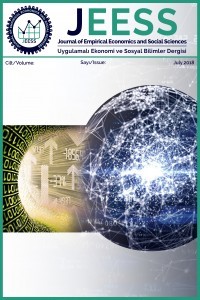BANKACILIK PİYASASINDA KREDİ TÜRÜNE GÖRE BELİRLENEN FAİZ ORANLARININ ENFLASYON VE DÖVİZ KURU İLİŞKİSİ
Türkiye’de enflasyon, döviz kuru ve faiz oranları etkileşiminin incelenmesi ve araştırılması küresel ekonomik sistemde son yıllarda artan volatilitenin etkisiyle daha da önemli hale gelmiştir. Bu çalışmada bankacılık sektörü kredilerinin türlerine göre faiz oranlarının enflasyon ve döviz kuru arasındaki ilişkileri incelenmiştir. Araştırmada kredi türlerine göre faiz oranları, döviz kurları ve enflasyon oranlarının 2007- 2019 yıllar arası aylık verileri alınmış olup Pesaran ve Shin (1999), Pesaran ve Shin (2001) tarafından geliştirilen Autoregressive Distributed Lag (ARDL) Sınır Testi uygulanmıştır. ARDL test sonuçlarına göre, Türkiye’de enflasyon ile belirlenen kredi türlerinin faiz oranları arasında ilişki bulunurken; döviz kurları ile belirlenen kredi türlerinin faiz oranları arasında herhangi bir ilişki bulunmamıştır.
Anahtar Kelimeler:
Döviz Kuru, Faiz Oranı, Enflasyon Oranı, Autoregressive Distributed Lag Sınır Testi
THE RELATIONSHIP BETWEEN INTEREST RATES OF THE CREDIT TYPE IN ACCORDING TO BANKING MARKET AND INFLATION AND EXCHANGE RATE
In Turkey, inflation, exchange rate and interest rates are examining the interaction and investigation, has become more important with the increasing impact of volatility in the global financial system in recent years. In this study, the relationship between interest rates and the inflation and exchange rates according to the types of banking sector loans examined. In this work surveyed in interest rates, exchange rates and inflation rates by loan types, which was taken as monthly data set between 2007 and 2019 and Autoregressive Distributed Lag (ARDL) Border Test developed by Pesaran and Shin (1999), and applied by Pesaran and Shin (2001). According to the ARDL test results in Turkey, there was no relationship between the exchange rates and the interest rates of loan types. While there is a relationship between inflation and interest rates of loan types.
___
- Bhattari K., Imact Of Exchange Rate and Money Supply On Growth, Inflation and Interest Rates in The UK, Monetary Economics and Finance, 4 (4), 2011, pp: 354-371.
- Dornbush, R., (1985), “Exchane Rates and Prices”, NEBER Working Paper No. 1769.
- Fama, E. F. (1975), “Short Term Interest Rates as Predictors of Inflation”, American Economic Review, 65, 269–282.
- Fisher, I., (1930), The Theory of Interest: As Determıned by Impatıence to Spend Income and Opportunıty to Invest it. Augustus M. Kelley· Publıshers Clifton, I974.
- Fizari F., Asari A. H. , Syuhada Baharuddin N., Jusoh, Zuraida Mohamad N., Shamsudin N., Jusoff, K.,(2011), “A Vector Error Correction Model ( VECM ) Approach in Explaining the Relationship Between Interest Rate and Inflation Towards Exchange Rate Volatility in Malaysia”, World Applied Sciences Journal 12 (Special Issue on Bolstering Economic Sustainability), ss. 49-56.
- Hüseyin Şen, Ayşe Kaya, Savaş Kaptan, Metehan Cömert, Interest Rates, Inflation, and Exchange Rates in Fragile Emes: A Fresh Look at The Long-Run Interrelationships, HAL Archives-Ouvertes, 10, 2019, ss. 1-28.
- İşçan, H., Durgun Kaygısız A., (2019), “Türkiye’de Döviz Kuru, Enflasyon ve Faiz Oranı İlişkisi: 2009-2017 Uygulaması”, Iğdır Sosyal Bilimler Dergisi, No:17, 581-604.
- Keminsky,G. ve Schumulkler,S. (1998). “ The Relationship Between Interest Rates and Exchange Rates in Six Asian Countries”, Word Bank, Development Economics and Office of the Chief Economist, Washington, D.C.
- Kholdy, S. ve Sohrabian, A. (1990). “Exchange Rates and Prices: Evidence from Granger Causality Test”, Journal of Post Keynesian Economics, 13, pp: 71-78.
- Kraay, A. (2000) Do High Interest Rates Defend Currencies During Speculative Attacks? World Bank Policy Research Working Paper, No: 2267.
- Maurice K. Shalishali, Johnny C. Ho, (2002), Inflaiton, Interest Rate, and Exchange Rate; What is The Relationship?, Journal of Economics and Economic Education Research, 3 (1), pp: 107-117.
- McCarthy, J. (2000), Pass-Through of Exchange Rates and Import Prices to Domestic Inflation in Some Industrialized Economies. New York Fed Staff Report, No:111.
- Meese, R., Kenneth R., (1988), “Was it Real? The Exchange Rate-Interest Differential Relation over the Modern Floating-Rate Period”, The Journal of Finance VOL. XLIII, NO. 4 September.
- Mishkin, F., (1991), “Is The Fısher Effect for Real? A Reexamination of The Relationship Between Inflation and Interest Rates”, NBER Working Paper No. 3632.
- Özel, Saruhan (2000): Türkiye’de Enflasyon, Devalüasyon ve Faiz, İstanbul, Alkım Yayıncılık.
- Rittenberg, L. (1993). “Exchange Rate Policy and Price Level Changes: Causality Test for Turkey in The Post Liberalization Period”, The Journal of Development Studies, 29, 245-259.
- Sever, E., Mızrak, Z., (2007), “Döviz Kuru, Enflasyon ve Faiz Oranı Arasındaki İlişkiler: Türkiye Uygulaması”, SÜ İİBF Sosyal ve Ekonomik Araştırmalar Dergisi, ss. 265-283. Şen, H., Kaya, A., Kaptan, S., Cömert, M., (2019) “Interest Rates, Inflation, And Exchange Rates In Fragile Emes: A Fresh Look At The Long-Run Interrelationships”, HAL Archives-Ouvertes, No: 10
- Wood, J. H. (1981). Interest Rates and Inflation, Federal Reserve Bank of Chicago Economic Perspectives, 5(May/June), 3–12.
- Yalçıner K., (2012), Uluslararası Finansman, 2. Baskı, Detay Yayıncılık, Ankara
- Yenice S., Yenisu E.,(2019), “Türkiye’de Döviz Kuru, Enflasyon ve Faiz Oranlarının Etkileşimi”, Sosyal Bilimler Enstitüsü Dergisi, Cilt: 21, Sayı:4, ss. 1065- 1086.
- ISSN: 2667-7210
- Başlangıç: 2018
- Yayıncı: Burak DARICI
Sayıdaki Diğer Makaleler
STUDY OF FACTORS AFFECTING CONSUMERS’ PURCHASING BEHAVIOR VIA ONLINE NETWORKS IN BANGKOK
STUDY OF FACTORS THAT EFFECT AND INFLUENCE ON THE PERSONAL FINANCIAL MANAGEMENT OF THE YOUNG ADULT
Ye Ko Ko HTET, Sumas WONGSUNOPPARAT
EVALUATING THE COST-BENEFIT OF A WASTE HEAT RECOVERY ENERGY SYSTEM WITH EXERGOECONOMICS
2008 KÜRESEL EKONOMİK KRİZİNİN TÜRÜ VE NEDENLERİ
